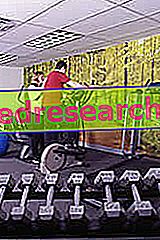Edited by Marco Batistoni
reflections on a case study
On 28/9/2006, 34-year-old Maria Rossi, happily married and mother of a 3-year-old child, introduced herself to me. She is a bubbly girl, always smiling, but afflicted by obesity.
At the first interview Maria is very worried: it comes from a long series of bankruptcy diets, she almost does not dare to hope to be able to reach the much-desired weight loss. He jokes about sizes and miniskirts, but behind the apparent lightness of the speech I notice his profound melancholy

So we begin the first anthropoplicometric examination: on a height of 165 cm and a weight of 108 kg, the skinfold data show a fat percentage of 33%, while the impedance test detects a percentage of fat mass of 39.5%.
In subsequent appointments I perform the usual tests with Maria: on the structural level she has a marked hyperlordosis, with a hyperciphosis due to a postural attitude induced, among other things, by a very abundant breast.
We perform the flexibility, strength and endurance tests, evaluate the VO2 and from here my exercise prescription starts: given the inactivity dating back to the beginning of the pregnancy (with an experience of light running only in the very rare moments of free time), I decide to start with a circuit training that involves the use of fitball, in order to develop its proprioceptive abilities.
Based on the findings, I recommend a nutrition education program that takes into account its basal metabolic rate and the energy expenditure caused by both training and the remaining daily activities.
As a patient Mary behaves very diligently, adheres scrupulously to the program, shows great determination; after about 3 months of training, its weight drops to 103 kg. The plicometric exam shows 30% fat while the impedance drops to 37.2%.
I often ask you if you follow food education correctly and continuously. She replies "Everything is ok, there are no problems".
The training sessions are also an important opportunity for me to evaluate the athlete on an emotional level: talking to Maria, I have reason to suspect that despite her claiming that "everything is fine" she is actually suffering from eating disorders: they make me suppose the his family history and the difficulties encountered in childhood and puberty. I then propose that you fill out an emotional / food diary, where you must record every day, 24 hours a day, what you eat, when, with whom, in which situations. From the diary it emerges that Maria is often alone, with the usual difficulties of a woman dealing with a small child, with the management of family life and a part-time job, and who often has attacks of hyperphagia, attacks that sometimes she also assail during training.
The training proceeds progressively and Maria, encouraged by the first results obtained, proves to be increasingly determined to follow the program.
In January, despite the intensity of the aerobic and anaerobic training, a stagnation of the results is known to be increasing: the anthropoplicometric tests do not report any noteworthy changes, so I decide to contact a trusted psychiatrist explaining the case and its problems: they are almost sure that Maria's problems are far more important than she herself is ready to admit and that they cannot be solved solely with an exercise prescription.
The psychiatrist confirms my assumptions, so I decide to talk about it with Maria. In fact, I believe that the main task of a personal trainer is to take care of the well-being and health of people as a whole, both physically and psychologically.
In my opinion, the concept of well-being goes far beyond the pure and simple state of physical fitness, the aesthetic improvements that in most cases constitute only the explicit part of the client's request and objectives. In this sense it is essential to train the instructor, who certainly cannot do operations of this kind with a light heart. Respect for the patient, the ability to get in tune with his emotions, to perceive his discomforts and to find the most suitable way, different for each specific case, to help him solve them, are things you learn with years of certified study and field experience. It is not possible to look for the result based only on training or, worse still, on one type of exercise or performance compared to another: often it is necessary to question the lifestyle, the type of diet (which, in turn, as we have seen, it depends strictly on the emotional situation) and to do this we need the preparation and humility to recognize where our competence ends and where that of other professionals begins, with whom we must be able to work in synergy.
But let's go back to Maria: during an interview full of emotion, she accepts my advice and decides to make an appointment with the professor.
He will then tell me that a long session brought out in detail all the problems that I had suspected during our work together. The psychiatrist prescribes two drugs that do not aim to help the patient "burn" the excess calories, but which are aimed at treating the causes that trigger the eating disorder (they therefore have sedative effects on hyperphagia).
In the meantime we continue training: alternating circuit training with sessions more focused on muscle strengthening, we arrive in mid-April. We perform the anthropoplicometric tests again: a fat percentage of 22% is highlighted, the weight has fallen to 95 kg and the impedance detects a 30% fat mass.
Now Maria is well, she trains with even more enthusiasm and determination, she has almost completely overcome the difficulties caused by the attacks of hyperphagia and has again seen her weight come down in a ponderous manner. I always tell her that we are only at the beginning that still has a long way to go, at the end of which a wardrobe full of miniskirts is waiting for her!
I chose to talk about this case study to highlight that for the success of an exercise prescription it is important to evaluate the subject at 360 degrees, to be ready and able to take charge of it as a whole, without fossilizing too much attention on the exercises or the tools as, unfortunately, we hear more and more frequently also in the media. There are no "miraculous" exercises or tools, no exercise, taken on its own and extrapolated from a certain type of context, has an intrinsic and fundamental value compared to others.
My conclusion? Well, this is it: the magic recipe does not exist, pace of the many fitness gurus. In our profession, the many skills (metabolic, biomechanical, nutritional, psychological, medical) are much more important (I would say they are fundamental), not so much to arrogate to us responsibilities that obviously do not compete for us, but to be able to understand when it is necessary to seek collaboration with other professionals for joint patient management.



